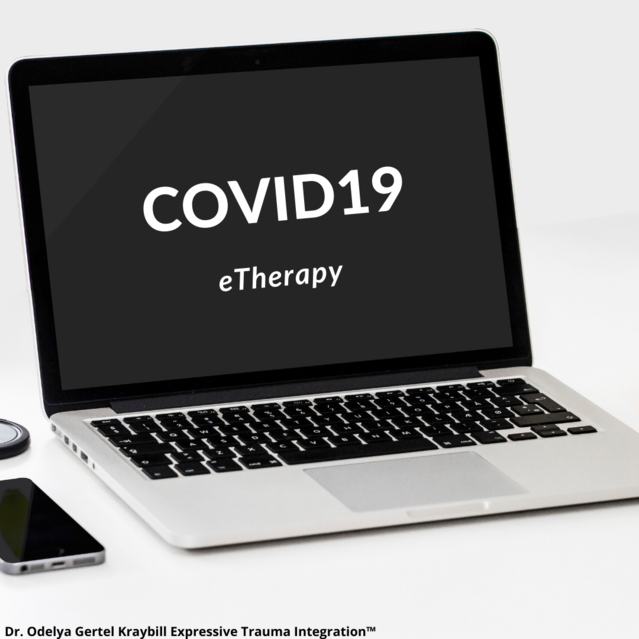Coronavirus Disease 2019
COVID-19: eTherapy in Times of Isolation
9 suggestions for facilitating therapy online with kids and adults.
Posted March 10, 2020 Reviewed by Hara Estroff Marano

The coronavirus presents difficult choices for all who spend time in therapy rooms, both clients and therapists. Psychiatrists Moukaddam and Shah recently blogged about the impact of COVID-19 on mental health.
Unusual times call for unusual solutions.
The coronavirus brings more than additional stress. It threatens the basic ability of human beings to meet and support each other. We have to be creative and flexible in responding to this crisis. These are unusual times, and unusual times call for unusual solutions. One key response must be expanding the use of digital therapy, sometimes called telemental health, which I’ll refer to here as etherapy.
It takes time and practice to adjust to etherapy. Every client is different, and as in face-to-face sessions, it is important to adapt sessions to the client’s needs, capacity, and circumstances.
Etherapy in practice.
The same principles that govern the client-therapist relationship in face-to-face settings apply in etherapy. The therapist has a duty to consider—and probably to discuss with the client—how to protect anonymity and confidentiality. A fundamental issue easy to overlook is making sure means of communication are HIPAA compliant.
A more complex challenge is the limitations inherent to the confined container for interaction provided by online therapy. As therapists, we are trained to interact with clients moment-by-moment in ways that support therapeutic goals. In daily practice, we give attention to how what we are doing supports the goals we seek.
In etherapy the options for interacting with clients are not as flexible as in face-to-face interaction. For example, we can't offer a glass of water, we can't lean next to a client and provide a gesture of comfort, we can't suggest going for a walk. If the client is a child, we rely on the presence of a parent to make sure the session is running smoothly.
This requires creativity and out-of-the-box thinking. In face-to-face sessions, many therapists adopt modalities other than sit-and-talk. We may go for a walk, draw, sing, dance, jump on the trampoline, or bake cupcakes. In etherapy sessions, we have to be even more creative and flexible in maintaining therapy objectives to help clients experience attunement, find ways to improve self-regulation, and build and maintain sustainability.
That said, it's important to recognize in this time of high stress that the same principle should guide etherapy as guides face-to-face therapy: In times of high stress, the short-term focus should be on containment and stress management. Stress is triggering, especially for survivors of trauma, and this is not the time to process trauma but to focus on safety, self-efficacy, identification of vulnerabilities and resources, and tactics that promote sustainability (more info in this blog).
Etherapy session with kids ages 5-10.
In most cases, etherapy with children younger than 10 assumes the presence of a parent in the session. If, like many therapists, you often have a parent in the room when you do face-to-face sessions, this is not an issue. Parents can benefit from observing and learn from the therapist-child interaction. In some settings, parents are active participants in a dyadic therapy format. So some clients are used to having a therapy session with a parent in the therapy room.
If this is not the case for you, you will need to introduce the client to the idea of the parent being present and discuss with the parent in advance some guidelines for their role in a joint online session.
Online sessions introduce you to the world of a child and their room, family room, or other space. This space has its own dynamics that affect what you choose to do. The child may feel comfortable or triggered. You can plan ahead of time and request that the parent/caregiver choose a space that is comfortable and likely to get the child to engage for a full session.
Ideas for interaction.
A key challenge in online therapy is figuring out ways to structure interaction with the client that work online. Below are some I find useful. Each has its own requirements for setting up—some require communication with parents in advance of the session with a child so they know what to do.
- Hidden object: Ask the child to count to 20 while the parent hides an object in a place that you can see on your screen. You will then guide the client who is looking for the object by calling out “Hot!” if he is close or “Cold!” if he is far. Alternatively, ask the child to hide the object and have the parent find it. Either way, you can get a glimpse of parent-child dynamics in their natural environment.
- Charades: This is a pantomime game in which someone acts out a word/phrase and others guess what it is. This can go in either direction—with the client or therapist acting out the word. Send parents a note in advance with a list of categories appropriate to the age and developmental stages of the child. For example: animals (dog, cat, fish, bird), activities (brushing teeth, driving, dancing, surfing), food (pizza, ice cream, bubblegum, taco), sports (tennis, car racing, soccer, baseball). Have the parent put some categories on slips of paper, each category on a separate slip. In a session, the child draws a slip of paper, announces the category to the therapist, and acts out the word for the therapist. Or vice versa.
- Timeline/journal: Ask the parents to prepare ahead of time a notebook, magazine, white paper, and crayons, marker, scissors, and glue. Together with the child, you can work on a calendar or daily art journal. The goal is for the child to write, draw, or otherwise creatively express themselves in whatever way feels right. This can also be used as a calendar that reflects the number of days that the child/family is expected to be in isolation.
- Color templates: You can send templates to the parents ahead of time to print and let the child color during the session.
- Other media: Some children, especially those suffering from developmental delays and/or attention and focus difficulties, will find it hard to engage in the ways suggested above for a full session. With them, it will be easier to mix and match the modalities of interaction. You can pick ahead of time a video that is meaningful for the child and watch it together (more on how in this post). Or you might play online UNO together, sing karaoke, or play online games. You will likely need to register ahead of time and try it out with parents to make sure it is a good fit.
Etherapy with adults.
As in a face-to-face session, you need to find a structure for interaction in which the client has space to express emotions, reflect on them, and then regroup internally before the session ends and the client returns to their routine. In a time of pandemic, this reality may seem more painful and isolated than usual.
This raises questions about what type of modalities are useful. In situations of high stress, my preference is to focus the attention of clients on recent experiences rather than past ones and to help them explore resources and strategies to manage stress. If the client is new and we have not yet established strong rapport, my preference in this direction is even stronger. This approach is closer to psychological first-aid than to traditional therapy.
Ideas for interaction.
- You can send a request to clients ahead of time to get crayons/markers and plain paper to draw or scribble on as you talk or as they see fit.
- You can send clients ahead of time templates for coloring that they can use in sessions or after.
- Validate and normalize clients' feelings of fear and sense of helplessness. Avoid trying to replace these with positive statements. Self-compassion can be very helpful at this time (read this blog post for more info).
- Everybody has resources. The mere fact that a client found you and asked for help is evidence that a client has abilities and resources to draw upon. Assist the client in making a list of these and use it to define their resilience and post-traumatic growth (read this blog post for more info).
- Teach your client to use the 5-4-3-2-1 exercise to ground and reconnect to the here and now.
- Use the GENA activity together with your client to help them reconnect to a safe place.




